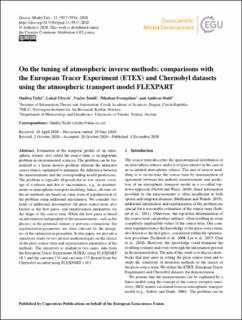| dc.contributor.author | Tichý, Ondřej | |
| dc.contributor.author | Ulrych, Lukas | |
| dc.contributor.author | Šmídl, Václav | |
| dc.contributor.author | Evangeliou, Nikolaos | |
| dc.contributor.author | Stohl, Andreas | |
| dc.date.accessioned | 2021-01-07T12:47:18Z | |
| dc.date.available | 2021-01-07T12:47:18Z | |
| dc.date.created | 2020-12-07T12:45:45Z | |
| dc.date.issued | 2020 | |
| dc.identifier.citation | Geoscientific Model Development. 2020, 13, 5917-5934. | en_US |
| dc.identifier.issn | 1991-959X | |
| dc.identifier.uri | https://hdl.handle.net/11250/2722026 | |
| dc.description.abstract | Estimation of the temporal profile of an atmospheric release, also called the source term, is an important problem in environmental sciences. The problem can be formalized as a linear inverse problem wherein the unknown source term is optimized to minimize the difference between the measurements and the corresponding model predictions. The problem is typically ill-posed due to low sensor coverage of a release and due to uncertainties, e.g., in measurements or atmospheric transport modeling; hence, all state-of-the-art methods are based on some form of regularization of the problem using additional information. We consider two kinds of additional information: the prior source term, also known as the first guess, and regularization parameters for the shape of the source term. While the first guess is based on information independent of the measurements, such as the physics of the potential release or previous estimations, the regularization parameters are often selected by the designers of the optimization procedure. In this paper, we provide a sensitivity study of two inverse methodologies on the choice of the prior source term and regularization parameters of the methods. The sensitivity is studied in two cases: data from the European Tracer Experiment (ETEX) using FLEXPART v8.1 and the caesium-134 and caesium-137 dataset from the Chernobyl accident using FLEXPART v10.3. | en_US |
| dc.language.iso | eng | en_US |
| dc.rights | Navngivelse 4.0 Internasjonal | * |
| dc.rights.uri | http://creativecommons.org/licenses/by/4.0/deed.no | * |
| dc.title | On the tuning of atmospheric inverse methods: comparisons with the European Tracer Experiment (ETEX) and Chernobyl datasets using the atmospheric transport model FLEXPART | en_US |
| dc.type | Peer reviewed | en_US |
| dc.type | Journal article | en_US |
| dc.description.version | publishedVersion | en_US |
| dc.rights.holder | © Author(s) 2020. | en_US |
| dc.source.pagenumber | 5917-5934 | en_US |
| dc.source.volume | 13 | en_US |
| dc.source.journal | Geoscientific Model Development | en_US |
| dc.identifier.doi | 10.5194/gmd-13-5917-2020 | |
| dc.identifier.cristin | 1856930 | |
| cristin.ispublished | true | |
| cristin.fulltext | original | |
| cristin.qualitycode | 2 | |

